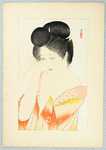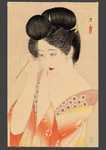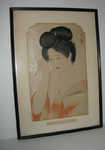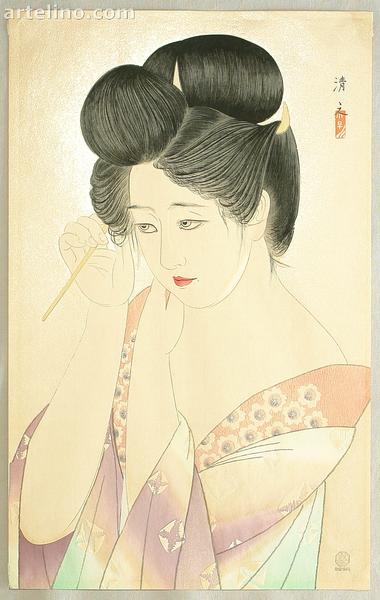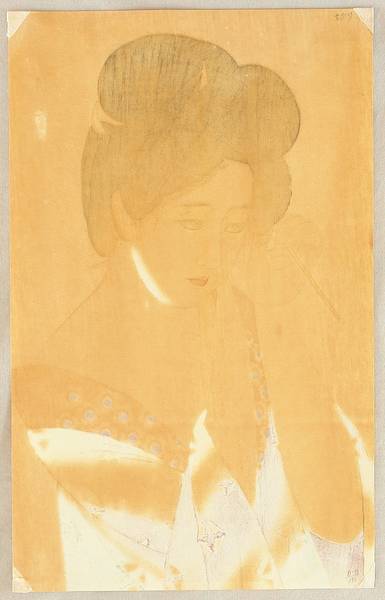| Notes (first edition)?: |
Kiyoshi Kohayagawa (1898-1948)
"Woman after a Bath" or "Dressing Her Hair"
There are perhaps two colour states for this scene: red and yellow robe, and purple and green robe. Or perhaps purple/green robe examples are just terribly faded versions of the red/yellow robe strikes.
作者:小早川清(明治32~昭和23)
画題:〔湯上がり〕
体裁:大判新版画〔40.6×26.2cm〕
署名:清、小早川
Artist: Kobayakawa Kiyoshi
Format: Large oban tate-e: 16" x 10.25" approx
Subject: Against a silver mica ground a bijin in a loosely fitting red and orange robe, makes adjustments to her hair.
Publisher: Takamizawa, Tokyo (on verso, bottom right).
Date: 1933
Literature Reigle-Stephens, Amy, "The New Wave: Twentieth Century Japanese Prints from the Robert O. Muller Collection", London and Leiden: Bamboo Publishing Ltd. And Hotei, ISBN 1-870076-19-2, - Pg. 145, pl. 195-2 |
|
| Notes (this edition)?: |
| The following information was taken from the original web listing of this artwork. Note that there may be some inaccuracies:
Title Dressing Her Hair
rare
Artist Kiyoshi Kobayakawa 1897-1948
Description "Kamiyui" (Dressing Her Hair). This design with red-yellow kimono has a different color version with greenish kimono. Kiyoshi KOBAYAKAWA was a traditional Nihon-ga artist and made only 13 designs for woodblock prints. All his beauties feature the soft, round face and and expressive eyes. This girl is quite involved in putting the final touch to her beautifully styled hair.
This design has another color version with orange robe.
Signature Kiyoshi.
Seal Artist's seal (Kobayakawa).
Dated 1931.
Publisher Tanryokudo.
Medium/Technique Woodblock print.
Impression Excellent ... Embossed.
Colors Very good ...Mica on the background, silver metallic pigment.
Condition Very good ... Discolorations on the lower area and along the jaw line. Light colored mat lines along the side edges. Mounting residues on the top corners on verso. The backside is toned but it is not affected the front.
Width Item 10.0 inches = 25.3 cm
Height Item 15.9 inches = 40.3 cm
Literature Reigle-Stephens, Amy, "The New Wave: Twentieth Century Japanese Prints from the Robert O. Muller Collection", London and Leiden: Bamboo Publishing Ltd. and Hotei, ISBN 1-870076-19-2, - Pg. 145, pl. 195-2 |
|
| Artist Bio: |
Kobayakawa Kiyoshi is best known for designing woodblock prints of modern Japanese women. Born in Hakata, a town in the Fukuoka Province of Kyushu, Kiyoshi was one of many artists who studied with Kaburagi Kiyokata, the famous painter and print designer. Kiyoshi entered Kiyokata's school at age twenty and probably knew Kiyokata's other students including Ito Shinsui, Kawase Hasui, and Torii Kotondo. Unfortunately, little is known about Kiyoshi's life compared to those other print designers. During the 1920's and 1930's, he exhibited Nihonga (Japanese-style) paintings at several exhibitions including the Kyodokai and the Imperial Academy Exhibition. In 1923, he contributed a print design to the series, "Complete Collection of Chikamatsu". This was probably Kiyoshi's first experience designing woodblock prints. Beginning in 1930, Kiyoshi began designing a series of six bijin prints which he called "Modern Fashionable Styles" (Kindai jisei sho). These prints were carved by Tadano Shichinosuke and printed by Ono Tomisaburo. The prints in this series were (1) Tipsy, (2) Powdering the Face, (3) Pedicure, (4) Expression of Eyes, (5) Black Hair, and (6) Rouge. Though most of these prints depict Japanese women engaged in traditional feminine pursuits, Tipsy is remarkable for its frank portrayal of a modern girl, or moga. It depicts a Japanese woman dressed in fashionable Western clothing and jewelry, drinking and smoking a cigarette. Her flirtatious, blurred gaze and her flushed cheeks indicate that she is intoxicated. This print was considered quite risque when it was first published. Kiyoshi designed thirteen prints in all, twelve of which were exhibited at the 1936 Toledo Exhibition. In addition to his six self-published prints, three were published by Hasegawa, three by Ensendo (Takamizawa) and one by Watanabe Shozaburo. Kiyoshi was awarded the special rank of Tokusen for his 1933 print, The Geisha Ichimaru. He died in April 1948 at Ikegami, Tokyo. Some of his woodblocks have been reprinted since his death and have later publisher's seals in the margin. Kobayakawa Kiyoshi is best known for designing woodblock prints of modern Japanese women. Born in Hakata, a town in the Fukuoka Province of Kyushu, Kiyoshi was one of many artists who studied with Kaburagi Kiyokata, the famous painter and print designer. Kiyoshi entered Kiyokata's school at age twenty and probably knew Kiyokata's other students including Ito Shinsui, Kawase Hasui, and Torii Kotondo. Unfortunately, little is known about Kiyoshi's life compared to those other print designers. During the 1920's and 1930's, he exhibited Nihonga (Japanese-style) paintings at several exhibitions including the Kyodokai and the Imperial Academy Exhibition. In 1923, he contributed a print design to the series, "Complete Collection of Chikamatsu". This was probably Kiyoshi's first experience designing woodblock prints. Beginning in 1930, Kiyoshi began designing a series of six bijin prints which he called "Modern Fashionable Styles" (Kindai jisei sho). These prints were carved by Tadano Shichinosuke and printed by Ono Tomisaburo. The prints in this series were (1) Tipsy, (2) Powdering the Face, (3) Pedicure, (4) Expression of Eyes, (5) Black Hair, and (6) Rouge. Though most of these prints depict Japanese women engaged in traditional feminine pursuits, Tipsy is remarkable for its frank portrayal of a modern girl, or moga. It depicts a Japanese woman dressed in fashionable Western clothing and jewelry, drinking and smoking a cigarette. Her flirtatious, blurred gaze and her flushed cheeks indicate that she is intoxicated. This print was considered quite risque when it was first published. Kiyoshi designed thirteen prints in all, twelve of which were exhibited at the 1936 Toledo Exhibition. In addition to his six self-published prints, three were published by Hasegawa, three by Ensendo (Takamizawa) and one by Watanabe Shozaburo. Kiyoshi was awarded the special rank of Tokusen for his 1933 print, The Geisha Ichimaru. He died in April 1948 at Ikegami, Tokyo. Some of his woodblocks have been reprinted since his death and have later publisher's seals in the margin.
|
|






